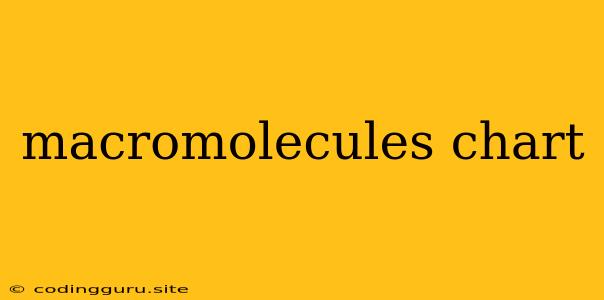Macromolecules: The Building Blocks of Life
Have you ever wondered what makes up the complex structures of living organisms? The answer lies in the fascinating world of macromolecules. These are large, complex molecules that play crucial roles in all living things. From the DNA that holds our genetic code to the proteins that build our muscles, macromolecules are the fundamental building blocks of life.
What are the four main types of macromolecules?
There are four primary categories of macromolecules that are essential for life:
- Carbohydrates: These are the primary source of energy for living organisms. They are made up of carbon, hydrogen, and oxygen. Examples include sugars, starches, and cellulose.
- Lipids (Fats): These are important for energy storage, insulation, and cell membrane structure. They consist of carbon, hydrogen, and oxygen, but with a higher proportion of hydrogen. Examples include fats, oils, and waxes.
- Proteins: These are the workhorses of the cell, involved in a wide range of functions including structural support, enzyme activity, and transport. Proteins are made up of amino acids, linked together in long chains.
- Nucleic Acids: These store and transmit genetic information. They are composed of nucleotides, which consist of a sugar, a phosphate group, and a nitrogenous base. DNA and RNA are the two main types of nucleic acids.
A Visual Representation: The Macromolecules Chart
To help visualize the differences between these crucial molecules, a macromolecules chart is a useful tool. A macromolecules chart typically outlines the four main types of macromolecules, highlighting their:
- Monomers: The building blocks of each macromolecule. For example, carbohydrates are made up of simple sugars (monosaccharides) as their monomers.
- Polymers: The large, complex molecules formed by joining many monomers together.
- Functions: The specific roles each macromolecule plays within a living organism.
- Examples: Specific examples of each macromolecule type.
How to Use a Macromolecules Chart
A macromolecules chart can be a valuable resource for:
- Students: To quickly grasp the differences between the four main macromolecules and their functions.
- Teachers: To provide a clear visual aid during biology lessons.
- Researchers: To have a quick reference guide for the fundamental building blocks of life.
Benefits of Using a Macromolecules Chart
A macromolecules chart offers several benefits:
- Clarity: It provides a clear and concise overview of the different macromolecules.
- Organization: It helps organize information in a structured and easy-to-understand format.
- Visualization: It uses visual aids to facilitate comprehension.
- Memorization: It aids in remembering the key features of each macromolecule type.
Finding a Macromolecules Chart
Macromolecules charts are readily available online and in various textbooks. Searching for "macromolecules chart" will yield numerous results.
Conclusion
Macromolecules are the essential building blocks of life, responsible for a wide range of functions within living organisms. Understanding their structure, composition, and roles is crucial for comprehending the complexities of biological systems. A macromolecules chart provides a valuable visual aid for learning and understanding these important molecules.
